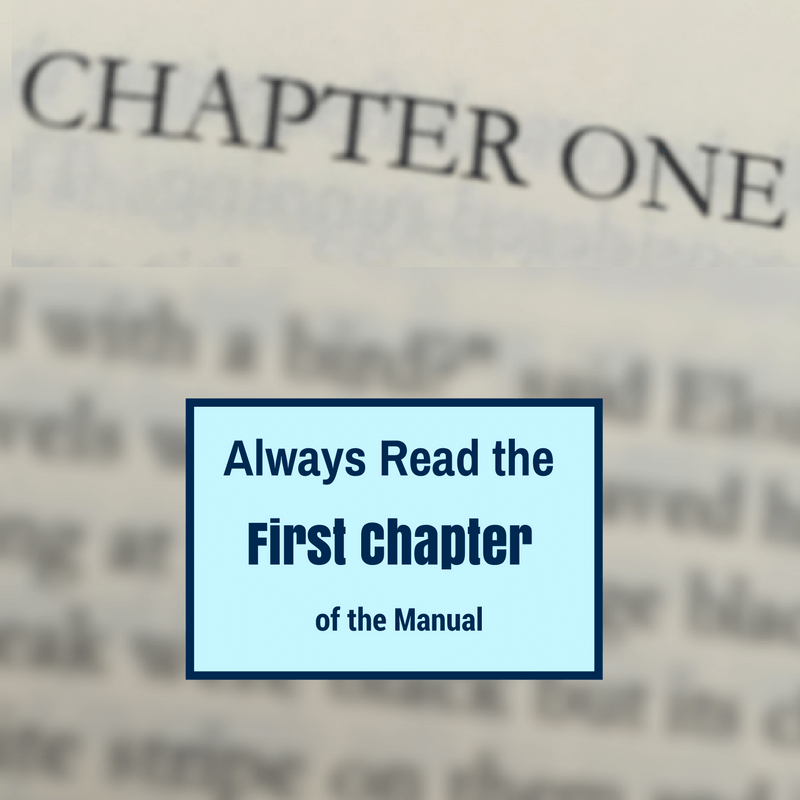Episode 65 : Always Read The First Chapter Of the Manual
In my first full-time job I worked for a small financial software company and had to learn this odd computer programming language that hardly any other companies used. As a new employee I was given the manual but most people just expected me to do what they did and just pick things up as I went along. But for whatever reason I read the manual. What surprised me was that I learnt an awful lot of things that many of the “old hands” didn’t know by just reading Chapter 1 of the manual. This is because what are the “basics” often change with time and they had simplified many things in the later versions of the language that they proudly announced in that first chapter.
In my own business related activities recently I discovered that I’d been doing some of the basics wrong and I’d forgotten the important lesson : always read the first chapter of the manual.
Reviewing the Basics
It’s not that you won’t know probably 90% of what it says, but the issue is that it is extremely easy to feel that you are an expert in things after you have been doing them for a while. But most people’s experiences are patchy. Even teachers usually have these blind spots. But it is so easy to fall into this idea that we have been doing things for so long that we don’t have to review the basics because we know them.
I was shaken first by something basic I was doing wrong with my podcast episode and that set me on the path to looking to review other basic things I was doing.
The first I picked up at the Podcast Movement. You might have noticed a slight improvement of the sound quality in some of the recent interviews I’ve done. At a session on podcast production the speaker said “Always record your audio on separate tracks”. When he said this I thought I can’t do that as I have a mixer and don’t use recording software to record them (which split the tracks for you). Someone else in the audience asked the question to him at the end, “how do I split tracks with a mixer?” and the speaker looked at the poor questioner like a moron and said “just pan yourself left and the interviewee right” and I suddenly realised that is what I should have been doing.
It makes editing the audio so much easier as you can easily remove noise from the non-speaking side when you produce the podcast episode. This began me on a journey of reassessing all aspects of my business. What else had I missed? I’ve already found two other things.
Show Notes
Firstly, those of you who look at my show description on a podcast player may have noticed they look a lot better. The way I had these originally set up was that it took an extract from my web-site post at BeginSelfPublishing.com associated with each episode and automatically analysed it to create a show summary. But these looked awful. For example I put something like Episode 65: Read Chapter 1 and a picture and then some text, but the summary would ram together the end of this line with the first line of the paragraph following the picture. It all looked pretty awful.
Ironically the fix for this I found when I was trying to fix a similar issue on my website itself. On the home page it has a list of all the recent episodes with a summary produced exactly the same way. So I wondered, there must be a way to improve the content of these summaries. I soon discovered they were called Excerpts and there was a way I could create a Manual Excerpt. On WordPress you can unhide a field called ‘Excerpt’ and enter exactly what you want to appear on this summary page.
As a happy co-incidence it also changes the poor podcast summaries as well to this formatted text because of the plug-in I use to create my podcast feed.
Always Read the First Chapter of the Manual to become an expert
The other thing I noticed was from trying to work out a similar annoyance. When editing my podcast audio in a computer program called Audacity it has this annoying feature when you playback audio of the place it plays it from jumping back to the same point all the time. In many cases this is what you want if you listen to the same bit all the time, but for me I like to play the show and write the show notes and I keep forgetting to manually move the play point at the end. With a bit of Googling I discovered if you press Shift-A then it will ‘Play with Transport’ and leave the play point from where you left off. Another case where I hadn’t read chapter 1 of the manual.
As I move into book-writing season I’m going to look to see if there are any of these kind of things in the way I write books. I’m sure there are in Scrivener and probably in the whole publishing process. The moral is to always periodically reassess even things you think you know how to do, because the improvements in how you do the basics might well be more productive than trying to become even more of an expert or learn new things.
If you liked this show then you might like My 3 Biggest Self-Publishing Mistakes , Author Income : How Many Books Do You Need to Sell to Make Money? and Was I Wrong about Fiction Book Content Marketing?

